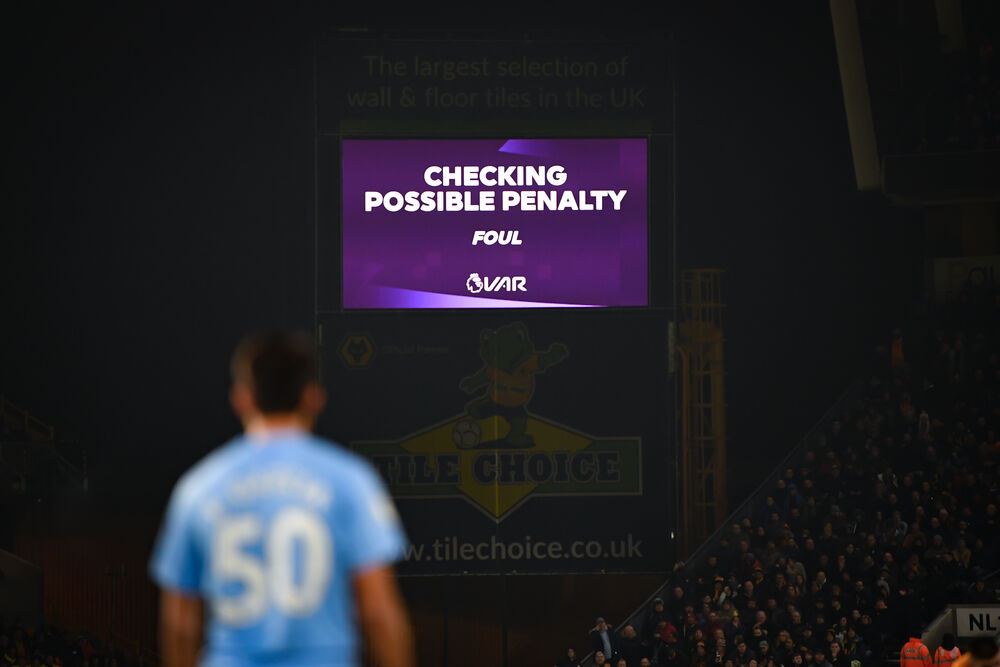The 2019/20 Premier League season has been the first to feature the Video Assistant Referee (VAR) after the clubs voted unanimously in November 2018 to introduce the system.
As expected with such a drastic change in how games are officiated, the introduction of VAR hasn’t been a smooth one. Many Premier League matches have been marred by controversy surrounding video technology.
Is VAR having the desired impact?
When considering the alternative, there’s little argument against the use of VAR. It minimises the impact of human error in officiating. While the teething problems will inevitably remain as long as the rules surrounding match officiating continue to evolve, the introduction of video technology has lead to more accurate officiating.
VAR was never introduced to achieve 100% accuracy for all decisions, but in November, the accuracy of decision making around key incidents, such as goals, red cards and penalties, was said to have increased from 82% last season to about 91% this term.
“The problem is that people are always looking and picking out the controversial things,” Lukas Brud, International Football Association Board (IFAB) secretary says. “…this will always be a problem of VARs. People just ignore how well it can work. Normally it works well, but as soon as it doesn’t, the discussions start again.”
It is understood referees remain satisfied with VAR’s introduction in the Premier League, with Neil Swarbrick, the Premier League referees’ lead on VAR, telling BBC Sport “I’m really pleased, honestly, with how we have started out… We have more decisions correct with VAR than without it.”
Both Brud and Swarbirck’s sentiments are supported by the numbers. So far, 63 goals or incidents have been directly affected by VAR. It’s not all negative either – 17 have lead to goals, seven have overturned an incorrect offside call and two red cards have been rescinded by the video referee.
On the surface, it seems like VAR is having the desired effect. Referees are getting a higher percentage of correct decisions and more obvious injustices are being eliminated from the game. It’s quite clear that VAR, when used correctly, can be a huge asset to the Premier League. However, there is, without doubt, plenty of room for improvement in how it has been implemented so far.
Clear and obvious
‘Clear and obvious’ is a phrase we’ve heard thrown around so often this season. According to the IFAB, VAR can be used to overturn a subjective decision if a “clear and obvious error” has been identified, i.e. not ‘was the correction decision made?’, but instead: “was the decision clearly wrong?”
While VAR has been consistent in how it determines offside, these decisions are made by the millimetre, often infuriating fans, players and coaching staff alike. One particular incident which bemused fans occurred in the November clash between Chelsea and defending champions Manchester City. Raheem Sterling’s goal was overturned after a VAR review determined he was marginally offside.
Happy to improve my VAR overruled goals record today again 💯 damn this thing gonna kill me bro 😂😂😂 #cursed pic.twitter.com/pLSjYkLp5Z
— Raheem Sterling (@sterling7) November 23, 2019
According to IFAB guidelines, VAR should not have been used in this instance. The goal should have stood, as the failure to identify the offside play was not a ‘clear and obvious’ error. In fact, it required reviewing of the Premier League’s multiple Hawk-Eye cameras, which are calibrated to give many options when showing an offside decision in the event that a body part is covered in one camera.
In defence of the Premier League’s approach, Dr. Tom Bennett of City Law School points out that “The IFAB’s laws do not explain what is meant by ‘clear and obvious’. No examples are given… This lack of clarity leaves a problematically broad degree of scope for the Premier League to interpret the ‘clear and obvious’ standard.”
IFAB: "In theory, 1mm offside is offside. But if a decision is taken that a player is not offside and the VAR is trying to identify through looking at five, six, seven, 10, 12 cameras whether or not it was offside, then the original decision should stand."
Premier League VAR: https://t.co/QzUb0LIyrl— Oliver Kay (@OliverKay) January 1, 2020
However, the IFAB general secretary Lukas Brud recently shared his thoughts on the topic, saying that officials on the pitch and monitoring cameras should not become “too forensic” over offsides or any other decisions. “If something is not clear on the first sight, then it’s not obvious and it shouldn’t be considered. Looking at one camera angle is one thing but looking at 15, trying to find something that was potentially not even there, this was not the idea of the VAR principle.”
Insufficient technology
It’s clear that Premier League officials are making an effort to place offside decisions in the same category as decisions made by goal-line technology. Former Premier League referee Peter Walton likened the two, saying that whether a call was made by ‘one foot or one millimetre, people can see it and accept the decision’.
However, the two cannot yet be paired as decisions that are ‘black and white’. If the Premier League is to continue adopting this ‘forensic’ approach to offside, they will need to improve the technology used.

Sharpe and Shafiq used the opening week offside call given against Raheem Sterling vs West Ham to illustrate why VAR can never be definitive.
Cameras used by Premier League VAR run at 50 frames per second. This means that in some instances, officials are simply unable to know with certainty that a player is offside. In fact, the margin of error could be as big as 38.8cm, according to Adam Shafiq and James Sharpe of the Mail on Sunday.
“If one picture is taken every 0.02 seconds, VAR has to choose the frame which shows the ball has categorically been touched. If Frame A shows the boot an inch away from the ball, then VAR has to take the next one in which the ball has definitely been played… In reality, though, the first point of contact will be somewhere between.”
I’m pro VAR by the way. Always have been, but this ‘you’re either offside or you’re not’ argument will be fine once we have the technology to prove it…and it will come: guess it will need some sort of in-ball technology to determine exact moment of contact.
— Gary Lineker 💙💛 (@GaryLineker) August 10, 2019
Neil Swarbrick conceded that “all that the VARs can use is the technology that’s there for them.” However, the league simply cannot go into the 2020/21 season disallowing goals based on minute margins with a flawed method.
Pitchside reviews
For many of us, the first glimpse at VAR came in 2017, when it was implemented across all matches in the Bundesliga and Serie A. These matches often saw match officials reviewing their own decisions, using a pitchside monitor to review subjective incidents. Despite the presence of these monitors at Premier League grounds, with a designated Referee Review Area (RRA), this is something we’ve yet to see through 21 rounds of Premier League football.
The Professional Game Match Officials Limited (PGMOL) had in fact instructed referees to use the monitors “sparingly” before the start of the season, after claiming it could take at least 90 seconds for each review. Instead, referees continue to take the advice of VARs, despite reviews often still clearing the 90 second mark.
Former Premier League referee Mark Clattenburg has shared his concern surrounding the lack of RRA use. ‘I raised this a while back. The reason they do not want this is because they fear it will slow the game down… The main concern is that the referee on the pitch is not offered another chance to see subjective incidents,’.
Last month Arsene Wenger, FIFA’s new chief of global football development, spoke on the issue after an IFAB meeting in Belfast. The ex-Arsenal boss said the failure of the Premier League referees to use the designated RRA to review their own decisions was his “most important worry”.
It seems strange, however, that the Premier League are willing to sacrifice accuracy to minimise the time taken for review, given their approach to offside decisions. Furthermore, the justification seems redundant now that we’ve seen lengthy reviews, despite the absence of RRA use.
During the match between Tottenham and Everton in November, the ball appeared to strike the arm of Dele Alli as he made an aerial challenge on Yerry Mina in his own box. However, a penalty was not awarded, even after a three-minute VAR review. VAR Anthony Taylor decided not to overturn Martin Atkinson’s on-field decision.
"I expect a penalty to be given…" 🙋♂️
Dermot Gallagher looks at Dele Alli's 'handball' in Sunday's game v Everton – and why it wasn't given pic.twitter.com/2tZqYyxhwg
— Sky Sports News (@SkySportsNews) November 4, 2019
According to Premier League rules updated for this season, it would appear that in this instance, the wrong call was made. The handball rule now has extra clarity as it no longer considers the player’s intent. In addition, IFAB says that having the hand/arm above shoulder height is rarely a “natural” position and a player is “taking a risk” by having the hand/arm in that position.
Some have even suggested that video officials are reluctant to overrule their colleague’s match decisions. Speaking to Radio 5 Live, Former England goalkeeper Paul Robinson said “It’s still a matter of opinion because it doesn’t clear up a clear and obvious error; it’s just someone else’s opinion,” “There’s a pecking order with referees. If you get a top referee making a decision, is the VAR willing to interfere with the senior referee’s decision?
It seems Mike Riley has instructed Premier League officials to go against IFAB protocol and it’s gone terribly wrong. By his own admission, VAR failed to overturn four incorrect decisions in the opening four rounds of Premier League action alone.
To ensure that the referee —and not the VAR— is the key match official, the referee should always make the decision. With referees not even offered a chance to review their own decision, many have found it difficult to accept decisions made by a video assistant, miles away at VAR headquarters in Stockley Park. In this iteration of VAR, match officials aren’t held accountable for their own decisions, and their video assistants are seemingly reluctant to overturn some of the incorrect subjective decisions.
The Premier League could take inspiration from Rugby Union’s use of video technology. In rugby, the match official will make an on-field decision and consult a television match official (TMO) for a second opinion. The TMO can also communicate with the referee at any time if he suspects foul play has gone unnoticed. The footage is usually shown on a big screen inside the ground and the referee has the option to make a quick decision himself, without any discussion with the TMO. World Rugby laws state that “the referee should not be subservient to the system” – something that match officials should look to replicate in the Premier League.
📺 "VAR should be changed to VR because they are the referees."
😡 "The referees on the pitch are not the refs."
🙅♂️ Jose Mourinho has already had enough of VAR in the @PremierLeague. pic.twitter.com/MKzqkYYczc
— SPORF (@Sporf) January 5, 2020
However, change seems to be on the horizon after Michael Oliver’s impromptu use of the screen in the FA Cup. According to PGMOL, there had been no change of policy ahead of the cup tie. However, Keith Hackett, the former referee who led PGMOL between 2004 and 2010, said it was an “interesting coincidence” that the first use of the RRA was in an FA-governed tournament, as the FA plays a key role in lawmaking with the IFAB.
Hackett added that Oliver’s use of the monitor will be a watershed moment for VAR in English football. “For me it was an iconic moment and it sends the signals out to people in the English game that this is not going to be the first or the last… It needs to be a regular occurrence and if we don’t learn from that, something is amiss.”
All things considered, VAR certainly isn’t the finished article right now. It’s often imperfect and pedantic, but the Premier League’s inaugural implementation of it shouldn’t be used against VAR long-term.
While league officials are satisfied with the implementation of VAR so far, they’re well aware of the room for growth. Swarbrick told BBC Sport: “We are open to evolving with this – it’s not a case of we’re not budging. We will listen to feedback and where we can improve things, we will do.”
With disgruntled fans, players and coaching staff across the nation, there is tremendous pressure on the Premier League to achieve ‘maximum benefit, minimum interference’. If the league seeks out advancements in technology and reviews their decision-making protocol, the technology can ultimately do more to help the sport than harm it and should be used in the 2020/21 Premier League season and beyond.







